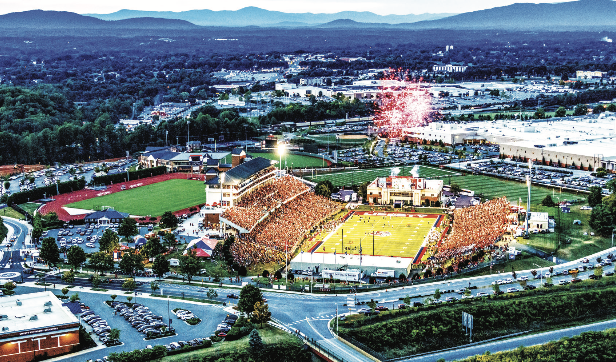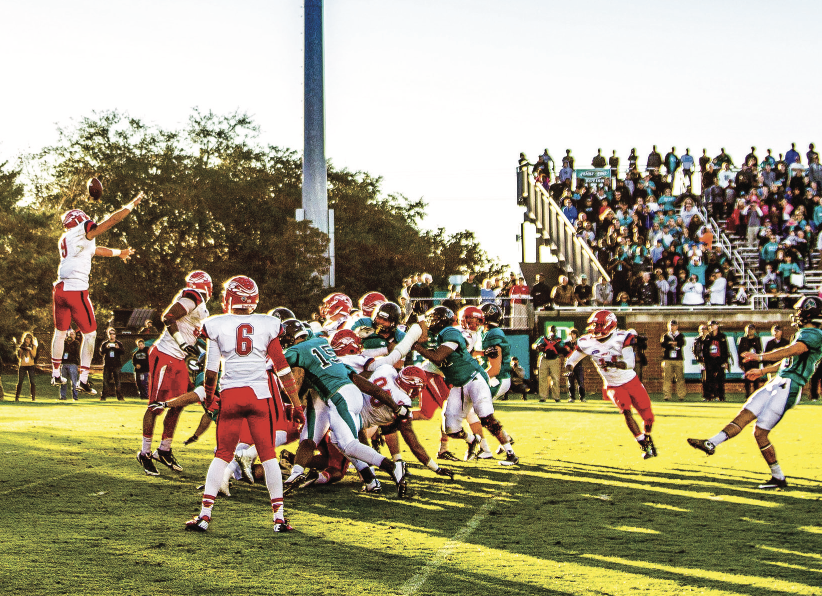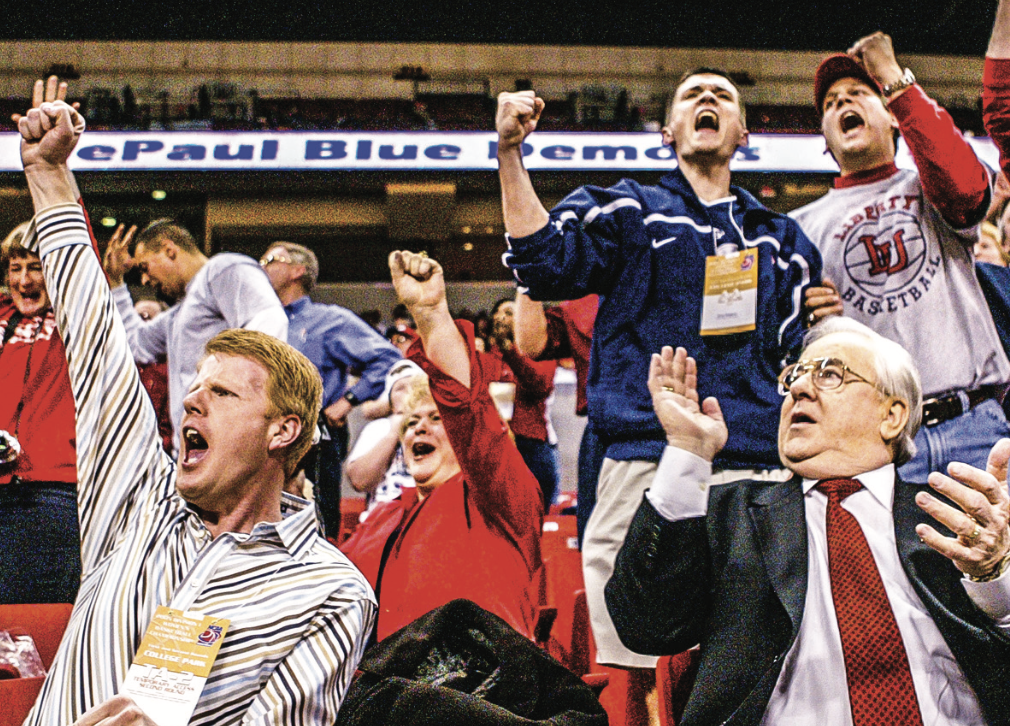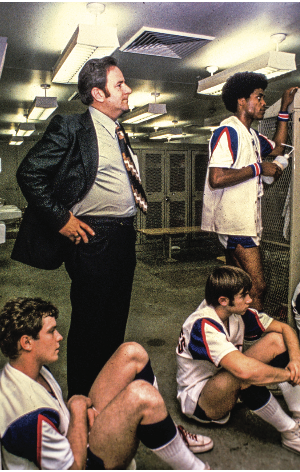Taking it to the highest level

Few universities in the country can say they have experienced the level of growth that Liberty University has seen over the last 10 years — particularly when it comes to the field of athletics.
That exponential growth is in large part due to the leadership of Liberty President Jerry Falwell Jr., who became president of the university 10 years ago after the passing of his father, Dr. Jerry Falwell Sr.
It had been Falwell Sr.’s dream since he founded Liberty in 1971 to develop the school into a major worldwide Christian university that would shine as a light for Christ. More specifically, he envisioned the Flames competing against other major religious universities in the world such as Notre Dame and Brigham Young University (BYU).
His emphasis on athletics as a means to reach the younger generation remained with Falwell Jr. when he took over the reins to the university, as evidenced by one glance at the athletic facilities that fill Liberty’s campus.
As Liberty proceeds with its $1 billion campus renovation project, almost 20 percent of that $1 billion has gone directly to benefit athletics, according to information recently released by the athletics department.
“(Falwell Jr.) has certainly seen the importance of athletics and trumpeted athletics since he’s been over the university,” Associate Athletics Director for Athletics Communications Todd Wetmore said. “You can see the financial support that he’s provided to athletics around the school — making sure they have the support.”
Perhaps the most important move for the Flames athletics program will be the football team’s move from Division I FCS to the Division I FBS ranks, the highest level of competition in college football.
The Flames will begin the two-year reclassification process in the 2017-2018 academic year, before competing as an FBS independent in the 2018 season and becoming bowl eligible in 2019.
“Our move to FBS football is a huge deal for the entire university, as it helps legitimize Liberty as a program that competes at the highest level,” Senior Associate Athletics Director for Internal Operations Mickey Guridy said. “It will help elevate the university’s profile even more. FBS status will help all of our athletic programs as we seek to recruit and retain top athletes who fit the mission of the university.”
While the move to FBS serves as the most important step the athletic department has taken under Falwell Jr.’s leadership, the improvements to athletic facilities around campus are definitely a close second.
Most recently, the Liberty Indoor Track Complex was completed this past winter. With a seating capacity of 2,500, the $30 million facility is one of the few in the country that has a six-lane, 200-meter, hydraulically banked oval track, according to libertyflames.com.
Brant Tolsma, who is in his 31st year of coaching the men’s and women’s track and field teams and serves as the winningest coach in the Flames athletics department, said the new facility is one of the best in the country and shows the commitment to athletics by the Liberty administration.
“We do want to be the premier Christian university in the world,” Tolsma said. “We do want to compete at the highest possible level in NCAA athletics, and we do want to excel at that level. (Administration) is providing everything we need to do it.”

The Flames defeated Coastal Carolina Nov. 14, 2014 to win the Big South Conference. Photo Credit: Kevin Manguiob
That desire from upper administration to compete at the highest levels of competition and succeed across the board in athletics can be seen in the various projects undertaken in the last 10 years around the Liberty campus.
Renovations to the Liberty field hockey and lacrosse fields along with the East Campus Field House gave the field hockey and lacrosse teams top-level facilities.
Both the baseball and softball programs received new stadiums, with Liberty Baseball Stadium finishing in 2013 while Kamphuis Field at Liberty Softball Stadium was completed in 2015. Both stadiums were recently named among the “7 Must-visit stadiums” listed by NCAA.com. Liberty is the only school on the list to have a top-seven baseball and softball stadium.
The Vines Center, home of the Flames men’s and women’s basketball teams along with the Lady Flames volleyball team, finished multi-year renovations in 2016. The renovations introduced four new locker rooms to the facility along with two new basketball practice courts and larger office spaces for coaches.
The combined Matthes-Hopkins Track Complex and Osborne Stadium serves as the home for men’s and women’s soccer as well as outdoor track events. In 2011, the track was resurfaced and permanent seating was added to the stadium along with a new video board.
“We don’t want to tell people, ‘In the next 10 years, we’re going to build this,’” Wetmore said. “We’re already here now.”
The university’s growth and the rise of more successful athletic programs have led to an increased number of staff along with a culture change inside the athletic department. Wetmore said the athletic department has almost tripled from an administrative standpoint, in large part benefitting the student-athletes.
“In order to have a strong athletics department, not only do you need good coaches and student-athletes, but you also need a support system behind them,” Wetmore said.
One source of the growing support of athletics is the Flames Club, a branch of the athletic department dedicated to raising funds for the Flames athletics teams.
Associate Athletics Director for Development and the Flames Club Bob Good has helped raise more than $12 million for the Flames since 2005 and witnessed first-hand the rise of the new athletic facilities across campus. During his tenure, the Flames Club has increased in membership from about 90 members to more than 1,000.

onathan Falwell and Jerry Falwell Sr. cheer on the Lady Flames basketball team in the 2nd round of the 2005 NCAA tournament. Photo Credit: Les Schofer
“Every sport has had something significant happen in terms of facilities,” Good said. “There’s not a sport that 12 years ago was competing or practicing in the same facility that they have today.”
Despite the growth of the last 10 years, Liberty’s athletic programs show no sign of slowing down. Three other projects for the athletics program are currently underway.
The $29 million Liberty Football Indoor Practice Facility is scheduled to be completed by Summer 2017, in time for the upcoming football season.
The football team and other Flames athletes will return in August to the new Academic and Performance Center (ACP), a 60,000-square foot, $32 million facility that, according to libertyflames.com, “will provide a centralized area for the academic pursuits of Liberty’s student-athletes, plus provide state-of-the-art strength and conditioning, nutrition and rehabilitation areas.”
Attached to the Liberty Indoor Track Complex will be the new Liberty Natatorium, a $19 million, 75,000-square foot facility that will consist of an eight-lane, 50-meter pool, according to libertyflames.com.
The various projects undertaken in the last 10 years, along with the current projects underway, are just one piece of evidence that points to the dedication from Falwell Jr. and the rest of the Liberty administration to make Falwell Sr.’s dream come true — to become the leading Christian university in the world.
“I am thankful for President Falwell’s leadership which has been focused on providing the resources to succeed at the highest level,” Carey Green, Liberty women’s basketball coach, said. “Over the past 10 years, I have observed an accelerated growth and development which has transformed Liberty athletics into a first-class program. The administrative support and our amazing facilities are second to none. It’s a great time to be a Liberty Flame.”
If the last 10 years are any indication of the future, the world of collegiate athletics needs to turn its attention to Lynchburg, Virginia, as Falwell Sr.’s dream of the Flames playing other nationally-known religious universities like Notre Dame and BYU is well on its way to becoming a reality.
Attached to the Liberty Indoor Track Complex will be the new Liberty Natatorium, a $19 million, 75,000-square foot facility that will consist of an eight-lane, 50-meter pool, and diving well, according to
libertyflames.com.
The various projects undertaken in the last 10 years, along with the current projects underway, are just one piece of evidence that points to the dedication from Falwell Jr. and the rest of the Liberty administration to make Falwell Sr.’s dream come true — to become the leading Christian university in the world.
“I am thankful for President Falwell’s leadership which has been focused on providing the resources to succeed at the highest level,” Liberty women’s basketball Coach Carey Green said. “Over the past 10 years, I have observed an accelerated growth and development which has transformed Liberty athletics into a first-class program. The administrative support and our amazing facilities are second to none. It’s a great time to be a Liberty Flame.”
If the last 10 years are any indication of the future, the world of collegiate athletics needs to turn its attention to Lynchburg, Virginia, as Falwell Sr.’s dream of the Flames playing other nationally known religious universities like Notre Dame and BYU is well on its way to becoming a reality.



